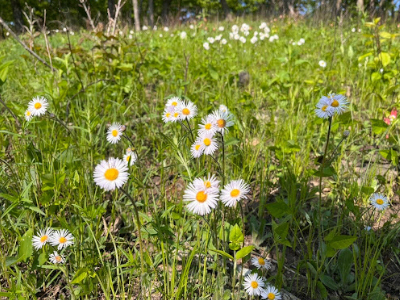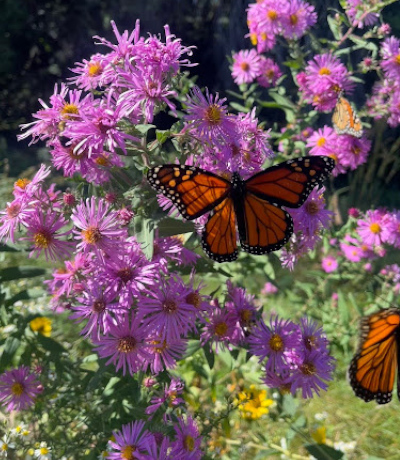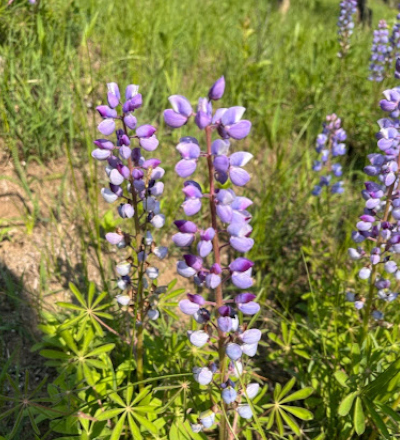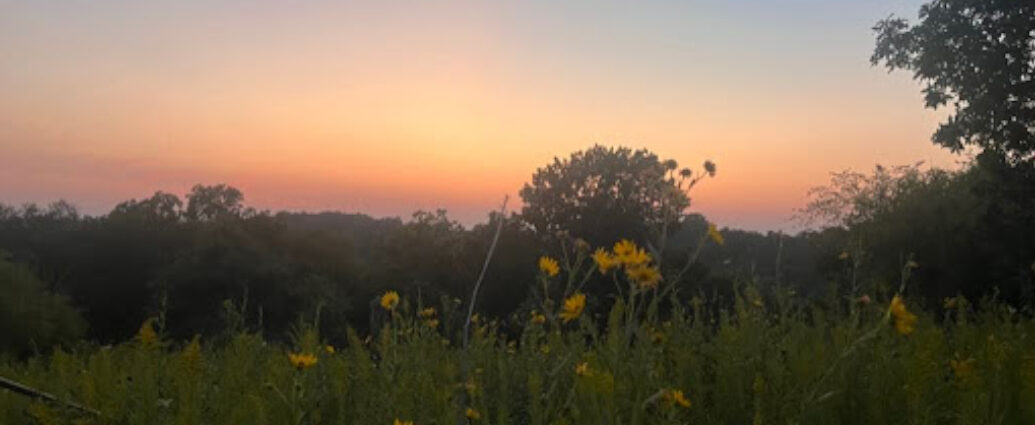Driftless in the Fall is magical: golds, reds, ambers, and yellows light up the sides of the bluffs—a siren call for tourists and natives alike to lift their eyes up to the show nature puts on each Autumn. When we think of the colors of the Driftless Region, it is often this “leaf season” that comes to mind first. Other seasons are thought to be dominated by a singular hue: in the Summer the bluffs are swarmed in green, in the Winter they are blanketed in white, and many think of Spring as a transition between the two—white giving way to green.
It may seem that way when we only look at the Bluffs as a whole, focusing on the macro view, but when we look a little closer, we will find that, like in the fall, the bluffs are a kaleidoscope of colors, of beauty. I am on a mission to share this Spring beauty, and to do so, I put on my light jacket and head outside.
So now that Spring has arrived, I take a deep breath of warmer air and find myself on the Bluffs.
 From this view, I can see the strong Mississippi surging with fresh snowmelt; all I can do is hope that it doesn’t get too high like it did last Spring. I move my eyes away from the captivating River and look a little closer at what is around me. Trees cover overhead and the white snow has given way to a variety of ground covers. Right now I see white flowers in all directions—the blooms of Bloodroot and Mayapple and Trillium. Bloodroot are tricky to find since they only last a couple of days, but when you see them, you know that Spring has arrived. Their red sap (or what some may call blood) reminds me of the life that Spring gives to the Earth (Mahr, n.d.). Mayapples, meanwhile, almost shout their arrival with their large multi-lobed leaves and their yellow centers (Krochmal, Wilkins, Van Lear, & Chien, 1974). Finally, Trillium, as the name might suggest, has three white petals and three green sepals protecting the petals. The petals definitely need protection as damage to (or picking of) a flower can injure the entire Trillium plant (U.S. Forest Service, n.d.).
From this view, I can see the strong Mississippi surging with fresh snowmelt; all I can do is hope that it doesn’t get too high like it did last Spring. I move my eyes away from the captivating River and look a little closer at what is around me. Trees cover overhead and the white snow has given way to a variety of ground covers. Right now I see white flowers in all directions—the blooms of Bloodroot and Mayapple and Trillium. Bloodroot are tricky to find since they only last a couple of days, but when you see them, you know that Spring has arrived. Their red sap (or what some may call blood) reminds me of the life that Spring gives to the Earth (Mahr, n.d.). Mayapples, meanwhile, almost shout their arrival with their large multi-lobed leaves and their yellow centers (Krochmal, Wilkins, Van Lear, & Chien, 1974). Finally, Trillium, as the name might suggest, has three white petals and three green sepals protecting the petals. The petals definitely need protection as damage to (or picking of) a flower can injure the entire Trillium plant (U.S. Forest Service, n.d.).
 I work my way closer to the edge of the woods and see Wild Geranium popping up. They don’t look quite like I expected when I think back to the Geraniums in my garden. However, the small purple flowers clustering together amongst large swaths of green pronged leaves seem to match the forest perfectly reminding me that thriving does not always look like what we expect, like the perfect garden (Taylor, n.d.).
I work my way closer to the edge of the woods and see Wild Geranium popping up. They don’t look quite like I expected when I think back to the Geraniums in my garden. However, the small purple flowers clustering together amongst large swaths of green pronged leaves seem to match the forest perfectly reminding me that thriving does not always look like what we expect, like the perfect garden (Taylor, n.d.).
I start working my way down the Bluffs. The soil is drier without the protection of as many trees, especially where the hill is steepest. It is here the Wild Lupines and Columbines thrive. Wild Lupines are endangered as their habitat of open, sunny, sandy areas is dwindling. So while I have the opportunity, I stop and listen to the call of these short poles with dozens of small purple flags fluttering in the wind, listen to them calling for my praise (Ruta McGhan, n.d.). The Columbines found in the Driftless Region are delicate and red with yellow interiors. They open early to give food to the hummingbirds as they prepare for spring (Mahr, n.d.). I strive to stand as tall and as proud as the Wild Lupines and as open as the Columbines.

Finally I am close to the riverbed and once again under the tree cover; here little white pants seem to be hung upside down to dry and a flower that looks suspiciously like Chamomile is urging me out of the trees and closer to the River. The Dutchman’s Breeches are just for visual enjoyment as they do not last when picked and are toxic if eaten (Hanson, n.d.). Similarly, Robin’s Plantain is not used as a herbal remedy like its twin chamomile, but just looking at both plants gives me courage and peace to put on my big girl breeches. Dutchman’s Breeches and Robin’s Plantain are the end of my Spring adventure through the Driftless Region.
I take one more deep breath before heading inside. After this adventure, I realize that the Spring flowers have given me more than just their pretty colors to observe. They’ve taught me the importance of protecting my heart, my lifeforce, like the Bloodroot and Trillium; of being patient with myself and letting go of impossible expectations like the Wild Geranium; of being proud of who I am like the Mayapple and Lupines; of still being caring and self-giving like the Columbines; and finally, of pushing myself forward like the Dutchman’s Breeches and Robin’s Plantain.
I urge you to take advantage of the next sunny Spring day and find yourself some wildflowers to emulate.
Writing and photos by Brady Bove



